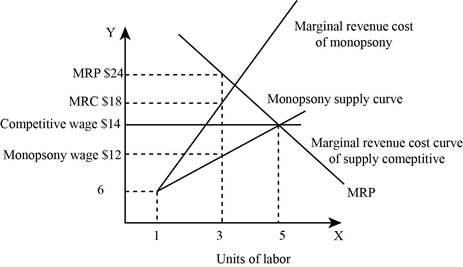
Concept explainers
Sub part (a):
The monopsony market.
Sub part (a):
Explanation of Solution
The total labor cost can be calculated by using the following formula.
Substitute the respective value in the equation (1) to calculate the total labor cost at one unit of labor.
The total labor cost is $3.
The marginal resource cost can be calculated by using the following formula.
Substitute the respective values in the equation (2) to calculate the marginal resource cost at one unit of labor.
The marginal resource cost is $3.
Table -1 shows the value of the total labor cost and the marginal resources cost that are obtained by using the equation (1) and (2).
Table -1
| Units of labor | Wage rate | Total labor cost | Marginal resources cost |
| 0 | - | 0 | |
| 1 | 6 | 6 | 6 |
| 2 | 9 | 18 | 12 |
| 3 | 12 | 36 | 18 |
| 4 | 15 | 60 | 24 |
| 5 | 18 | 90 | 30 |
| 6 | 21 | 120 | 36 |
The total revenue can be calculated by using the following formula.
The
Substitute the respective value in the equation (3) to calculate the total revenue at one unit of labor.
The total revenue is $34.
The marginal product can be calculated by using the following formula.
Substitute the respective values in the equation (4) to calculate the marginal resource cost at one unit of labor.
The marginal product is $17.
The marginal revenue product can be calculated by using the following formula.
The
Substitute the respective values in the equation (5) to calculate the marginal revenue product.
The marginal revenue product is $34.
Table -2 shows the value of the total revenue, the marginal revenue product and the marginal product that is obtained by using the equation (3), (4) and (5).
Table -2
| Units of labor | Total product | Marginal product | Product price | Total revenue | Marginal revenue product |
| 0 | 0 | 2 | 0 | ||
| 1 | 17 | 17 | 2 | 34 | 34 |
| 2 | 31 | 14 | 2 | 62 | 28 |
| 3 | 43 | 12 | 2 | 86 | 24 |
| 4 | 53 | 10 | 2 | 106 | 20 |
| 5 | 60 | 7 | 2 | 120 | 14 |
| 6 | 65 | 5 | 2 | 130 | 10 |
Graph -1 shows the firms labor supply and the marginal resources cost.7

In graph -1, the horizontal axis measures the units of labor and the vertical axis represents the wage rate. The discrete nature of problem requires that the (MRP) marginal revenue product should be equal or greater than the marginal resources cost. This marginal revenue cost curve lies above the labor supply because the employing of the next worker needs a higher wage in the market and will have to pay a higher wage for all the workers.
Concept introduction:
Monopsony: The monopsony market refers to a market which consists of a single buyer who hires a particular type of labor. The workers provide labor to this type of market that has a limited employment opportunity as they need to acquire new skills to be hired. The firm is the wage marker.
Subpart (b):
How many workers should the firm employ.
Subpart (b):
Answer to Problem 3P
The firm should employ 3 workers.
Explanation of Solution
When the marginal revenue product for this worker is greater than the marginal cost, then the firm should employ the workers. From the table, the firm should employ three workers. For the first worker, the marginal revenue product is $34 and the marginal revenue cost is $6. Thus, the firm should employ the first worker. For the second worker, the marginal revenue product is $28 and the marginal revenue cost is $12. So, the firm should employ the second worker. For the third worker, the marginal revenue product is $24 and the marginal revenue cost is $18. So the firm should employ the third worker. But for the fourth worker, the marginal revenue product is $20 and the marginal revenue cost is $24. So, the firm should not employ the forth worker.
Subpart (c):
What happens to the monopolist employment and equilibrium wage rate.
Subpart (c):
Explanation of Solution
In this, the monopolist employment decreases by 2 units and the equilibrium wage rate is $2 which is less than the competitive wage.
Want to see more full solutions like this?
Chapter 17 Solutions
EBK MICROECONOMICS
- Please solve this, no words or explanations.arrow_forward17. Given that C=$700+0.8Y, I=$300, G=$600, what is Y if Y=C+I+G?arrow_forwardUse the Feynman technique throughout. Assume that you’re explaining the answer to someone who doesn’t know the topic at all. Write explanation in paragraphs and if you use currency use USD currency: 10. What is the mechanism or process that allows the expenditure multiplier to “work” in theKeynesian Cross Model? Explain and show both mathematically and graphically. What isthe underpinning assumption for the process to transpire?arrow_forward
- Use the Feynman technique throughout. Assume that you’reexplaining the answer to someone who doesn’t know the topic at all. Write it all in paragraphs: 2. Give an overview of the equation of exchange (EoE) as used by Classical Theory. Now,carefully explain each variable in the EoE. What is meant by the “quantity theory of money”and how is it different from or the same as the equation of exchange?arrow_forwardZbsbwhjw8272:shbwhahwh Zbsbwhjw8272:shbwhahwh Zbsbwhjw8272:shbwhahwhZbsbwhjw8272:shbwhahwhZbsbwhjw8272:shbwhahwharrow_forwardUse the Feynman technique throughout. Assume that you’re explaining the answer to someone who doesn’t know the topic at all:arrow_forward
- Use the Feynman technique throughout. Assume that you’reexplaining the answer to someone who doesn’t know the topic at all: 4. Draw a Keynesian AD curve in P – Y space and list the shift factors that will shift theKeynesian AD curve upward and to the right. Draw a separate Classical AD curve in P – Yspace and list the shift factors that will shift the Classical AD curve upward and to the right.arrow_forwardUse the Feynman technique throughout. Assume that you’re explaining the answer to someone who doesn’t know the topic at all: 10. What is the mechanism or process that allows the expenditure multiplier to “work” in theKeynesian Cross Model? Explain and show both mathematically and graphically. What isthe underpinning assumption for the process to transpire?arrow_forwardUse the Feynman technique throughout. Assume that you’re explaining the answer to someone who doesn’t know the topic at all: 15. How is the Keynesian expenditure multiplier implicit in the Keynesian version of the AD/ASmodel? Explain and show mathematically. (note: this is a tough one)arrow_forward
- Use the Feynman technique throughout. Assume that you’re explaining the answer to someone who doesn’t know the topic at all: 13. What would happen to the net exports function in Europe and the US respectively if thedemand for dollars rises worldwide? Explain why.arrow_forward20. Given the mathematical model below, solve for the expenditure multiplier for a) government spending, G; and b) for consumer taxes, T. (medium difficulty) Y=C+I+G C=Co+b(Y-T) 1 = 10 T=To+tY G = Go+gYarrow_forwardUse the Feynman technique throughout. Assume that you’re explaining the answer to someone who doesn’t know the topic at all: 11. What exactly is a rectangular hyperbola and what relevance is it to classical economics?arrow_forward
 Managerial Economics: Applications, Strategies an...EconomicsISBN:9781305506381Author:James R. McGuigan, R. Charles Moyer, Frederick H.deB. HarrisPublisher:Cengage Learning
Managerial Economics: Applications, Strategies an...EconomicsISBN:9781305506381Author:James R. McGuigan, R. Charles Moyer, Frederick H.deB. HarrisPublisher:Cengage Learning
 Principles of Economics 2eEconomicsISBN:9781947172364Author:Steven A. Greenlaw; David ShapiroPublisher:OpenStax
Principles of Economics 2eEconomicsISBN:9781947172364Author:Steven A. Greenlaw; David ShapiroPublisher:OpenStax Principles of MicroeconomicsEconomicsISBN:9781305156050Author:N. Gregory MankiwPublisher:Cengage Learning
Principles of MicroeconomicsEconomicsISBN:9781305156050Author:N. Gregory MankiwPublisher:Cengage Learning Microeconomics: Private and Public Choice (MindTa...EconomicsISBN:9781305506893Author:James D. Gwartney, Richard L. Stroup, Russell S. Sobel, David A. MacphersonPublisher:Cengage Learning
Microeconomics: Private and Public Choice (MindTa...EconomicsISBN:9781305506893Author:James D. Gwartney, Richard L. Stroup, Russell S. Sobel, David A. MacphersonPublisher:Cengage Learning





